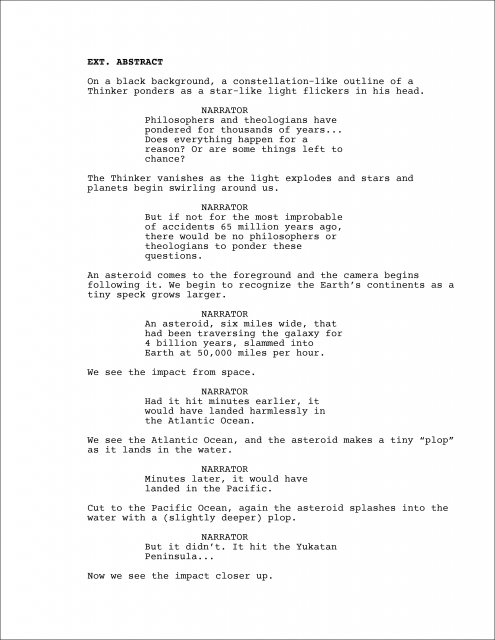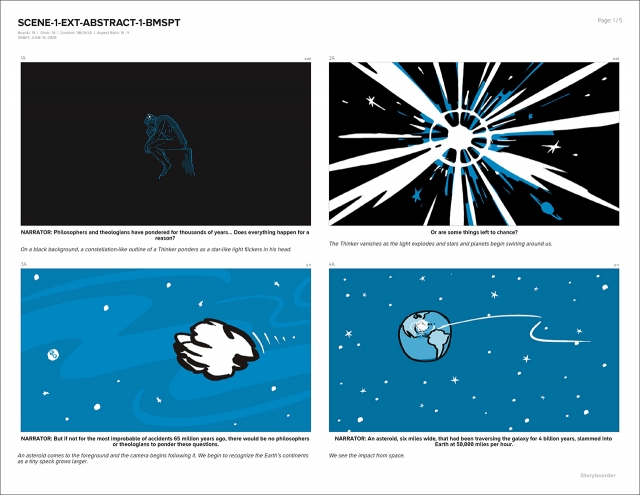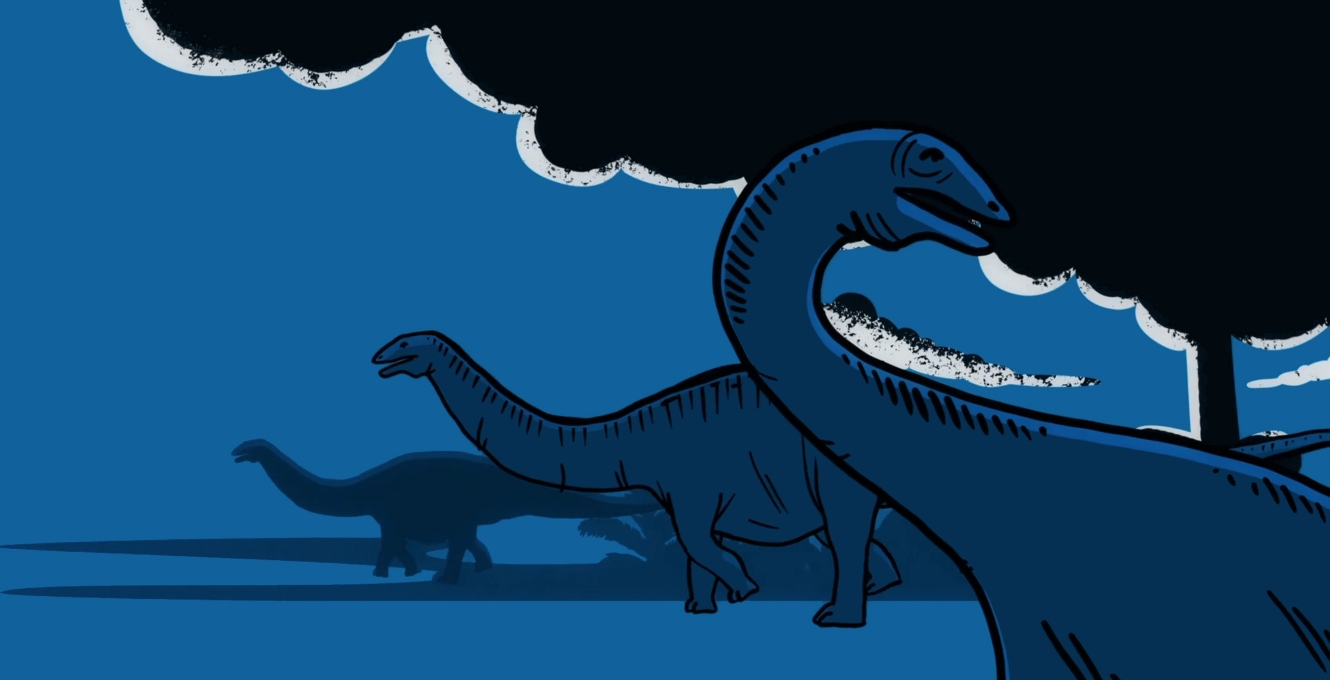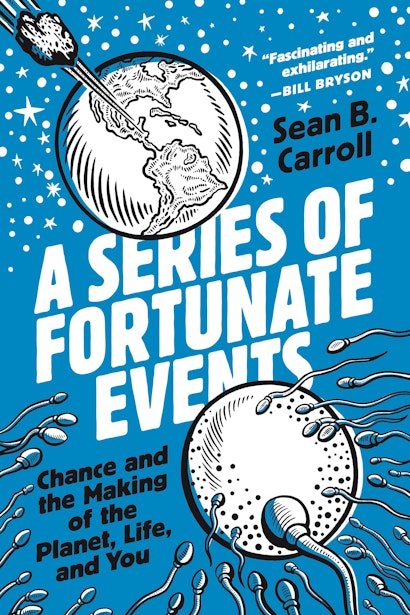In a world governed by chance, one book peers into the randomness of existence. From cosmic collisions and tectonic shifts to the infinitesimal accidents of biology, Sean B. Carroll’s A Series of Fortunate Events ranges across time and space, showing how chance occurrences brought us to where we are, fashioned us as we are, and contributed to all the beauty and diversity we see around us. In that same world, a book trailer has emerged, seemingly by design, to promote this extraordinary book and pique our interest. I spoke with animation expert Aaron Brown on creating the trailer and reckoning with happenstance.
Aaron, you’ve produced three animated trailers for PUP—for Gods and Robots, Red Meat Republic, and Artificial You. Tell me about your creative process. Where do you begin?
AB: I read a summary of the book, which is provided to me at the start of each project. When a full manuscript is available, I’ll speed read as much of it as possible before I begin, or I’ll have my computer read it to me aloud in the background while I’m doing other work.
Once I’ve wrapped my head around the overarching concepts in a book, I do my best to distill it all down into a one- to three-minute script, touching on all of the important points, and rendering it in narrative style. This is challenging, but it’s the kind of challenge I enjoy.
Once all of the stakeholders are happy with the script, I create a storyboard with rough illustrations of each shot to be animated. We may iterate on that a couple times, and then the final storyboard becomes the basis for the illustrations and the final animation.
Natalya Balnova’s illustrations are one of the book’s most remarkable features. What was it like adapting another artist’s work while maintaining the visual style of the book?
AB: Natalya provided me with all her wonderful artwork so that I could use it both for animation and inspiration. The primary elements from the book cover (the asteroid and Earth, the egg and sperm) were used extensively in the trailer animation, and then I created additional illustrations to tell the story while trying to capture the feeling of Natalya’s original work.

What tools do you use to animate?
AB: I write all of my scripts in an open source screenwriting software called Highland, which I highly recommend. Highland then exports the approved script into an open-source script format called Fountain. Then I’m able to import that script into another great piece of software called Storyboarder, which automatically detects scene breaks in a standard screenplay format and creates an organized storyboard file for me to start drawing in.

I draw each frame of the storyboard using a stylus monitor (currently a Huion KAMVAS model), and if I want more advanced brushes or editing tools, I can easily jump over to Photoshop, work on a storyboard frame there, and then return to Storyboarder to see it in context.

Once I have an approved storyboard, I usually export each panel as a still image and time them out to a scratch track [rough playthrough] using After Effects or Adobe Animate. This timed-out storyboard is known as an animatic.
I use the storyboard sketches as my reference for creating final illustrations in Photoshop and Illustrator, and I use the animatic as my timing reference when animating each shot.
If a shot or book trailer involves primarily motion graphics, I will animate it using After Effects, which is great for manipulating images and creating certain procedural effects. For example, the stars that explode out of the Big Bang and swirl past the camera in the trailer were created in After Effects using a particle simulator plugin and various 3D motion and warping effects.
If a shot or trailer calls for more character animation (like the ones for Gods and Robots and Artificial You), I will use software called Moho Pro and create “rigs” or digital puppets of each character that need to be animated. Moho can quickly and easily turn an illustrated character into an animatable rig. It’s been used in animated series like Puffin Rock and feature films like Song of the Sea and The Breadwinner to create complex animations that would otherwise be too involved to animate traditionally.
Given the complex software you use, traditional animation seems worlds away.
AB: It used to be that every frame of animation had to be drawn by hand on paper, and this is still done quite a bit. But technology gives us a lot more options. Animators can draw frame by frame directly on their computer (we call this “tradigital” animation), or they can use the kind of animation rigs I’m talking about to save time and/or stylize their work. But the creative process hasn’t changed much. We still start with writing, sketching, and storyboarding. We just use a computer for some or all of those steps now.
“Tradigital” is a nice portmanteau. I see exactly how it applies to creative practices today. Turning to audio, how do you go about choosing music to create a mood?
AB: I really just go by instinct when it comes to music. I’m a songwriter and musician, so I have a pretty good sense of the mood a piece needs to have, as well as tracks that can potentially complement the animation rather than distract from it. Afterwards, I edit the music to fit the length of the animation.
Do you work with sound and/or voiceover narration from the beginning, or do you add it later?
AB: I try to find the right music early on in the process, usually by the time the storyboard is complete. This allows me to time cuts between shots to the beat of the music. When there is voiceover, I record a scratch version of it myself at the tempo that feels right to me, and I time the animatic and animation to this. There’s always some adjustment needed when I get the final voiceover recording, but it’s typically very minor.
This book explores the role of chance in the creation of all things. Were there any “happy accidents” in the creation of this video or in your collaborations? What role does chance play in your work?
AB: When I was six years old, I came down with pneumonia and spent several days in bed. My dad had to work from home while I was sick, so he set me up with an old black-and-white TV in my room for the week. This was back in the days when there were only five or six television stations; whatever they were showing is what you had to choose from.
I came across Alfred Hitchcock’s classic The 39 Steps. It’s about a character who is mistaken for someone else, and he’s pursued by a network of spies led by an evil mastermind with a missing finger. In one scene, the hero and heroine have been captured, and they speak in closeup in the back seat of their captor’s car. As they finish speaking, the camera moves out of the car and rises up above the road, the car driving away into the distance.
As a 6-year-old, I wondered, “How did they do that?” I became fascinated with both the narrative and technical aspects of visual storytelling. And since I had already been interested in drawing and computers, I began to teach myself digital animation. If I hadn’t gotten pneumonia and seen Hitchcock’s film, I might be doing something else!
Christopher Lapinski is the Art & Design Coordinator for the Creative Media Lab. Aaron Brown is the owner and director of AB Positive, a startup animation studio. Natalya Balnova is an illustrator based in NYC; she is represented by Marlena Agency. Donna Liese coordinated the production of the book trailer for A Series of Fortunate Events. Chris Ferrante designed and art directed the book cover and interior for A Series of Fortunate Events.

